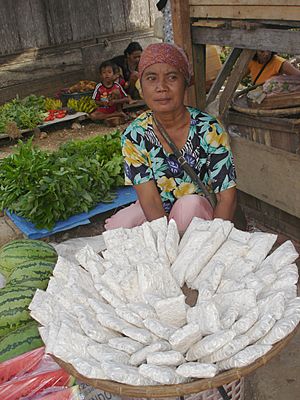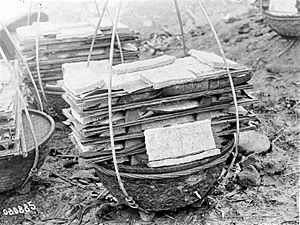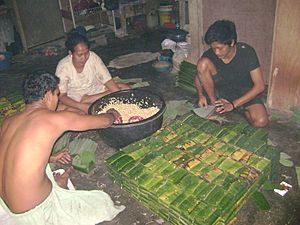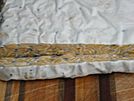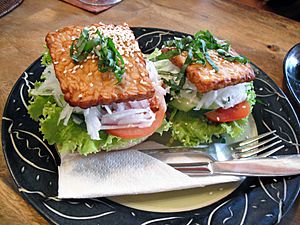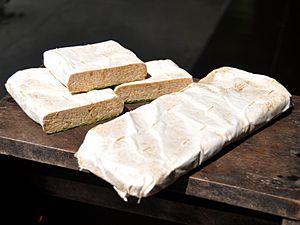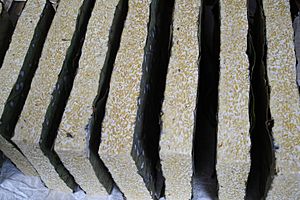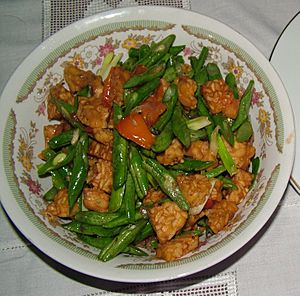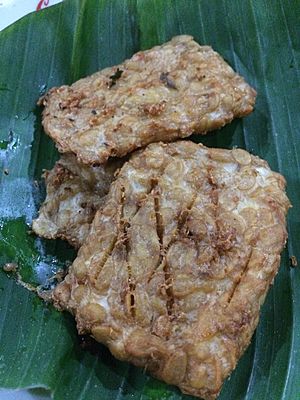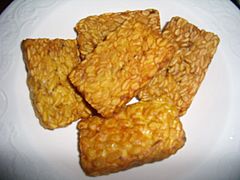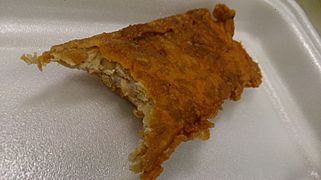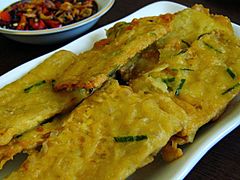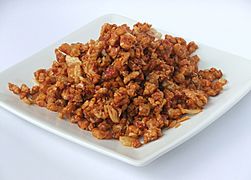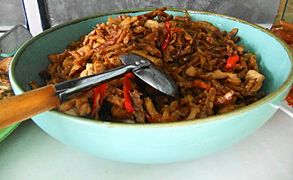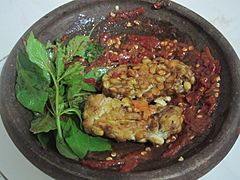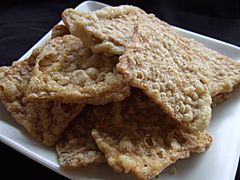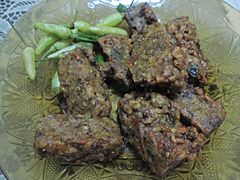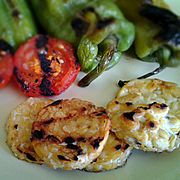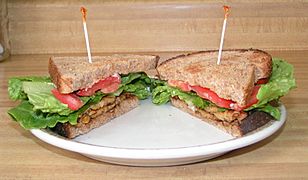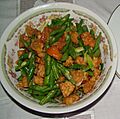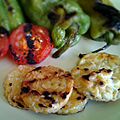Tempeh facts for kids
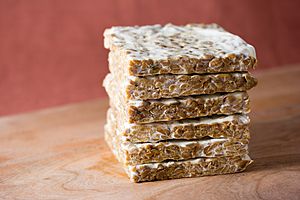
Fresh tempeh
|
|
| Alternative names | Tempe |
|---|---|
| Place of origin | Indonesia |
| Region or state | Central Java, East Java, Special Region of Yogyakarta |
| Main ingredients | Soybeans |
Tempeh or tempe is a traditional Indonesian food. It is made from soybeans that have been fermented. This means a natural process uses a special fungus to bind the soybeans together. The fungus, called Rhizopus oligosporus or Rhizopus oryzae, acts like a "starter" to create the tempeh.
Tempeh is very popular on the island of Java in Indonesia. It is a main source of protein there. Like tofu, tempeh is made from soybeans. However, tempeh uses the whole soybean. This gives it different nutrients and a firmer texture. The fermentation process and using the whole bean mean tempeh has more protein, dietary fiber, and vitamins. It feels firm when you eat it and has an earthy taste. This taste gets stronger as it gets older.
Contents
- What's in a Name?
- Where Did Tempeh Come From?
- How Tempeh is Made
- Tempeh's Nutrients
- Cooking with Tempeh
- Different Kinds of Tempeh
- Popular Tempeh Dishes
- Fried Tempeh: Tempe goreng
- Sweet and Savory Tempeh: Tempe bacem
- Flash-Fried Tempeh: Tempe mendoan
- Crispy Tempeh: Tempe kering
- Soft Stir-Fried Tempeh: Tempe orek
- Stir-Fried Tempeh with Veggies: Tumis tempe
- Smashed Tempeh: Tempe penyet
- Tempeh Skewers: Tempe satay
- Tempeh Chips: Kripik tempe
- Grilled Tempeh
- Tempeh Sandwich or Burger
- Keeping Tempeh Fresh
- Images for kids
- See also
What's in a Name?
The word tempe likely comes from an old Javanese word, tumpi. This word described a white, fried food made from sago or rice flour. It looked a bit like a crispy snack called rempeyek. Some historians also think it might be linked to the word tape or tapai, which means 'fermentation'.
In countries outside Indonesia, the spelling tempeh is most common. This helps people say the word correctly, so it doesn't sound like "temp". This spelling first appeared in a German article in 1896. By the 1960s, tempeh became the standard way to spell it in English.
Where Did Tempeh Come From?
Tempeh began in Indonesia, most likely in central or east Java. Experts believe it was discovered hundreds or even more than a thousand years ago.
The creation of tempeh depends on a special fungus. This fungus naturally grows on leaves from trees like teakwood and sea hibiscus. People in Java traditionally used these leaves to wrap food. In fact, when making tempeh the old way, they use a leaf already covered in this fungus. They call it usar. This is instead of buying a starter from a store.
At first, tempeh was made using black soybeans, which grew naturally in the area. Later, white or yellow soybeans were brought in. These became popular with the rise of the tofu industry.
Debates About Tempeh's Start
Some food historians, like Murdijati Gardjito, believe tempeh was created by native Javanese people. They think it was made even before Chinese-style tofu came to the island. Old writings mention tempe dhele, which means 'native soybean tempeh'. The word dhele referred to the local black soybean. White soybeans, used for most tempeh today, were called dhele putih and arrived in Java much later.
Other historians, like Ong Hok Ham, suggest tempeh might have been a side product of making tofu. They argue that both foods use soybeans. They think tempeh might have been accidentally created in the 17th century. This could happen if discarded soybeans caught the spores of an edible white fungus.
However, tofu was (and still is) made from white soybeans. These soybeans originally came from Japan and China. The earliest tempeh, tempe dhele, was made from native black soybeans. Tofu became popular among the rich first because it was expensive to make and used imported soybeans. Later, it became available to everyone.
Eventually, tempeh also started to be made with white soybeans. This led to less use of the native black variety. The original black soybean tempeh has largely been forgotten.
How Tempeh is Made
To make tempeh, whole soybeans are first soaked to soften them. Then, their outer skins are removed, and they are partly cooked. Some special types of tempeh can be made from other beans, wheat, or a mix of beans and whole grains. Sometimes, vinegar is added during soaking. This can change the final taste and feel of the tempeh.
The main step is the fermentation of the soybeans. This happens when Rhizopus molds are added. These molds are a type of fungus. A starter, which contains the spores of Rhizopus oligosporus or Rhizopus oryzae, is mixed with the beans. The beans are then spread out in a thin layer. They ferment for 24 to 36 hours at about 30°C (86°F).
The soybeans need to cool down first. This allows the mold spores to grow well. After a few hours, the temperature of the beans will naturally rise. The mold grows quickly for about 4 hours. As the mold growth slows, the soybeans should be held together in a solid block by the mold's white threads, called mycelium. In good tempeh, the beans are tightly connected by this white mat. Tempeh is usually ready after 48 hours. It will have a clear white color, a firm feel, and a nutty taste. If it ferments too long, it can become darker and taste less good.
During fermentation, the right conditions are important. These include the correct time, temperature, oxygen, moisture, and pH levels. This helps the Rhizopus mold grow and stops bad germs from growing. The pH level should be around 3-5. This is done by adding a mild acid like vinegar. Oxygen is needed for the mold to grow, but too much can cause unwanted germs. If the temperature is too low or there's too much air, gray or black spots of spores might form. This is normal and safe to eat. A mild smell of ammonia is also normal for good tempeh.
Traditional tempeh in Indonesia is often made using Hibiscus tiliaceus leaves. The fuzzy underside of these leaves naturally carries the Rhizopus oligosporus mold. Soybeans are pressed into the leaf and stored. This leads to fermentation and the creation of tempeh.
What Makes Good Tempeh?
After tempeh is made, its quality is checked. Good tempeh has beans that are tightly held together. A thick, even, white mycelium covers the whole block. The beans should be hard to see. Good tempeh smells pleasant, clean, and slightly sweet, like mushrooms. The whole block should stay together when gently shaken.
Unfinished tempeh has beans that are loosely held. The white mycelium is thin, and it crumbles easily. This tempeh needs more time to ferment. If it's still unfinished after enough time, it should be thrown away.
Inedible tempeh has a bad smell, like strong ammonia or alcohol. This means bad bacteria have grown, usually from too much moisture or heat. This tempeh is wet, slimy, and mushy. Its color is tan to brown, and the mold grows in patchy spots. This kind of tempeh should never be eaten.
How Tempeh is Packaged
Special food-safe paper and plastic bags with small holes are best for packaging tempeh. These help keep tempeh fresh for about three days longer than if it were left open. Good packaging is important because it lets the right amount of oxygen in. This helps the mold grow during the making process.
Tempeh goes bad quickly. It must be wrapped and put in the refrigerator or freezer right after it's made. When storing it, don't stack too many blocks together. This can cause them to get too warm and keep fermenting, which makes them spoil faster. Even in the cold, tempeh slowly changes. So, it should be cooled for at least two to five hours before being fully packaged. Tempeh in perforated bags is often put into another sealed bag for selling and labeling.
Tempeh's Nutrients
| Nutritional value per 100 g (3.5 oz) | |
|---|---|
| Energy | 803 kJ (192 kcal) |
|
7.64 g
|
|
|
10.80 g
|
|
|
Protein
|
20.29 g
|
| Vitamins | Quantity
%DV†
|
| Thiamine (B1) |
7%
0.078 mg |
| Riboflavin (B2) |
30%
0.358 mg |
| Niacin (B3) |
17%
2.640 mg |
| Vitamin B6 |
17%
0.215 mg |
| Folate (B9) |
6%
24 μg |
| Vitamin B12 |
3%
0.08 μg |
| Minerals | Quantity
%DV†
|
| Calcium |
11%
111 mg |
| Iron |
21%
2.7 mg |
| Magnesium |
23%
81 mg |
| Manganese |
62%
1.3 mg |
| Phosphorus |
38%
266 mg |
| Potassium |
14%
412 mg |
| Sodium |
1%
9 mg |
| Zinc |
12%
1.14 mg |
| Other constituents | Quantity |
| Water | 60 g |
| †Percentages estimated using US recommendations for adults. | |
Tempeh is mostly water (60%). It has a good amount of protein (20%), some carbohydrates (8%), and fats (11%). A 100-gram serving of tempeh has 192 calories. It is also a great source of several B vitamins and minerals. For example, it provides a lot of riboflavin and manganese.
How Fermentation Helps
The carbohydrates in tempeh become easier to digest because of the fermentation. The special Rhizopus mold greatly reduces certain sugars that can cause gas and indigestion. In traditional tempeh making, the starter often has good bacteria. These bacteria can produce vitamins like B12.
The fermentation process also lowers the amount of phytic acid in soy. Phytic acid can stop your body from absorbing minerals. By reducing it, tempeh allows your body to get more of the good minerals from the soybeans.
Cooking with Tempeh
The simplest way to cook tempeh is by frying it. You can deep-fry it or stir-fry it. In Java, tempeh is often cut into pieces and soaked in a mix of garlic, coriander, turmeric, salt, and water. Then, it's deep-fried and often served with a chili paste called sambal ulek. Cooked tempeh can be eaten by itself or added to chili, stir-fries, soups, salads, sandwiches, and stews.
Tempeh has a complex taste that people describe as nutty, meaty, or like mushrooms. It freezes well and is now sold in many supermarkets. You can steam it, marinate it, slice it thin, or crumble it into sauces. Tempeh can be grated and used instead of ground beef in dishes like tacos. When sliced thin and deep-fried, it gets a crispy outside and stays soft inside. Its sponge-like texture makes it great for soaking up marinades.
Different Kinds of Tempeh
The most common tempeh is made from fermented soybeans. This is called tempeh kedele or tempeh dele. However, other ingredients can be used. These include ampas tahu (tofu leftovers), ampas kelapa (coconut leftovers), and peanuts. These are made in a similar way to tempeh. A related food is oncom, which is made from peanut or soy leftovers. It is popular in West Java. There are two types of oncom: a bright red-orange one and a black one.

Tempeh can also be different based on how long it ferments. Tempe mondhol is not fully fermented. The mold has not completely covered it. The beans taste firmer. Sometimes tempeh is left to ferment longer, which makes it smell stronger. This includes tempe wayu (day-old tempeh), tempe semangit (a few-days old tempeh), and tempe bosok (meaning 'rotten tempeh'). Tempe bosok has black mold and a strong smell.
Some types of tempeh use ingredients that would otherwise be thrown away. This follows old Javanese customs of not wasting food. The leaves used to wrap tempeh can also add to its flavor. While traditional banana or teak leaves are used, plastic wraps are now common.
Tempeh from Soy Pulp: Tempe gembus
This is a soft and fluffy tempeh made from soy pulp, which is what's left after making tofu. Tempe gembus is usually cheaper than regular soybean tempeh. It's used in many dishes, like fried with batter or in vegetable stews.
Older Tempeh: Tempe semangit
In Indonesia, tempeh that is two or more days old is a special food. It's called tempe semangit ('stinky tempeh') in Java. It has a slightly strong smell. Small amounts are used to add flavor to traditional Javanese dishes like sayur lodeh (vegetable stew).
Leaf-Wrapped Tempeh: Tempe gódhóng
In Javanese, gódhóng means 'leaf'. Traditionally, tempeh is wrapped in banana leaf, Hibiscus tiliaceus leaf, or teak leaf.
Pure Tempeh: Tempe murni
This is pure soybean tempeh, made in plastic wrap without any other ingredients. It is meant to be very clean and free from unwanted microbes.
Mixed Bean Tempeh: Tempe menjes kacang
A special tempeh from Malang, Indonesia. It has a rough texture and is made from black soybeans mixed with other things like peanut leftovers and cassava fiber.
Dangerous Tempeh: Tempe bongkrèk
Tempe bongkrèk is a type of tempeh from Central Java. It is made with coconut leftovers. This tempeh has caused serious food poisoning and even deaths. This happens when it gets contaminated with a certain bacteria. This bacteria makes toxins from the coconut. Because of the danger, selling tempe bongkrèk is now against the law. However, some people still make it secretly because they like the taste. Regular bean and grain tempeh is safe because it doesn't have the right fats for the dangerous bacteria to grow.
Oat Tempeh
Scientists in Sweden created a type of tempeh using barley and oats instead of soy. This means it can be made in places where soybeans don't grow well.
Popular Tempeh Dishes
The easiest and most common way to cook tempeh is by frying it. Here are some other ways it's prepared:
Fried Tempeh: Tempe goreng
This is perhaps the simplest and most popular way to prepare tempeh in Indonesia. The tempeh is sliced and seasoned with garlic, coriander seeds, and salt. Then, it's deep fried in palm oil. It can be fried plain or coated in a batter first.
Sweet and Savory Tempeh: Tempe bacem
Tempe bacem is a traditional Javanese dish. The tempeh is first cooked slowly in coconut water, palm sugar, and spices. Then, it's briefly deep-fried. The result is a moist, sweet, and slightly spicy tempeh with a dark color.
Flash-Fried Tempeh: Tempe mendoan
This dish is common in Purwokerto. The tempeh is dipped in spiced flour and quickly fried in very hot oil. It's cooked on the outside but still soft or partly raw inside. It has a soft texture, unlike fully fried crispy tempeh.
Crispy Tempeh: Tempe kering
Also known as kering tempe ('dry tempeh'). This is a crispy, sweet, and spicy fried tempeh. The raw tempeh is cut into small sticks and deep-fried until dry. Then, it's mixed with palm sugar, chili, or other spices, or with sweet soy sauce. It can also be mixed with fried peanuts and anchovies. This dry tempeh can last for about a month if stored correctly.
Soft Stir-Fried Tempeh: Tempe orek
This is similar to tempe kering but is softer and moister. It gets its sweet taste from a lot of kecap manis (sweet soy sauce).
Stir-Fried Tempeh with Veggies: Tumis tempe
Stir-fried tempeh with vegetables like green beans or onions, and spices. Some recipes add coconut milk to make it creamy.
Smashed Tempeh: Tempe penyet
Fried tempeh mixed with sambal chili paste using a mortar and pestle. It's usually served with other "smashed" dishes like chicken or ribs.
Tempeh Skewers: Tempe satay
Tempeh cut into pieces, put on skewers, and grilled like satay. A type called sate kere ('poor man's satay') from Solo is made from fluffy tempe gembus.
Tempeh Chips: Kripik tempe
Kripik tempe are snack crackers. Thinly sliced tempeh is battered and deep-fried until crispy. They are popular across Java.
Grilled Tempeh
Tempeh cooked over charcoal or fire.
Tempeh Sandwich or Burger
Cooked tempeh patties placed between bread slices or hamburger buns with salad and sauces.
- Tempeh dishes
-
The common tempeh goreng (un-battered) in Indonesia
-
Fried tempeh (battered) sold at a food court in Singapore
-
Crispy kripik tempeh as a snack
Keeping Tempeh Fresh
Fresh, raw tempeh can be eaten for a few days at room temperature. It has natural substances that help it resist spoiling.
When cooked as tempe kering (dry tempeh), the deep-fried and seasoned pieces can last for a month or more. This is because deep-frying removes moisture, which stops further fermentation and spoilage.
Natural Protectors in Tempeh
The Rhizopus molds that ferment tempeh create natural substances that fight against bad germs. These substances help keep the tempeh fresh longer. The mold can stop other fungi from growing. It also produces substances that fight against harmful bacteria.
Storing Fresh Tempeh
Fresh tempeh can be sold and eaten within 48 hours after it's made. It's often carried to markets in its original wrapping and kept in the shade. In warm places, tempeh can stay good at room temperature for one to three days before it gets too ripe. In cooler places, it can last one to four days, but usually needs to be refrigerated to prevent spoilage.
Refrigerating Tempeh
Fresh tempeh should be sealed in a plastic bag and kept in the refrigerator below 40°F (4°C). It can stay fresh for three to five days, sometimes up to a week. If you quickly cook it by blanching or steaming it before refrigerating, it can last two or three weeks. This stops enzymes and destroys bacteria.
Freezing Tempeh
Freezing is the best way to keep tempeh fresh for a long time, especially for shipping it far away. You can freeze whole blocks or slices. Whole tempeh is frozen in its original wrapper. Sliced tempeh is put in a sealed plastic bag. This method keeps tempeh good for months with only a small change in texture and flavor.
Blanching Tempeh
Quickly cooking tempeh by steaming or parboiling helps it last longer. This stops bacteria and mold from growing and deactivates enzymes. Steaming seems to keep the texture, flavor, and nutrients better than parboiling. Blanching is great for tempeh you plan to refrigerate.
Drying Tempeh
Drying is another way to preserve tempeh.
Air Drying
Tempeh can be dried using hot air. Cubes of tempeh are placed on trays and dried with circulating hot air. This reduces the moisture content. When stored in special bags, it can last for several months at room temperature. However, hot air drying can cause some loss of nutrients.
Sun Drying
This is the cheapest drying method. Tempeh can be blanched first to keep its flavor. It's dried in a solar dryer at temperatures around 180-200°F (82-93°C). One downside is that sunlight can destroy some of the vitamin B12 in tempeh.
Freeze-Drying
This is the most expensive drying method. However, it keeps tempeh fresh for a very long time at room temperature. It also keeps most of the nutrients. The tempeh is quickly frozen and then dried in a strong vacuum. Because of the costly equipment, freeze-dried tempeh is more expensive.
Spray-Drying
This method is used to make tempeh powder for things like soups or breads. It's usually for small particles. This method can also be expensive due to the large equipment needed.
Deep-Frying for Preservation
This method makes ready-to-eat tempeh. Tempeh is deep-fried in oil until golden brown and crispy. Then, it's cooled quickly and sealed in bags. This can last about a week. If the tempeh is sun-dried or oven-dried before deep-frying, it can last even longer.
Images for kids
-
Tempeh-making process using a sealed polyethylene pouch
-
Tempeh traditionally wrapped in banana leaf
-
Sayur lodeh often has tempeh produced from advanced stages of fermentation mixed in for flavor
-
The common tempeh goreng (un-battered) in Indonesia
-
Fried tempeh (battered) sold at a food court in Singapore
-
Crispy kripik tempeh as a snack
See also
 In Spanish: Tempeh para niños
In Spanish: Tempeh para niños


